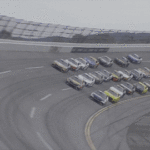The Indianapolis 500, also known as the Indy 500, is an iconic American motorsport event that has a rich and storied history. The first race took place in 1911 at the Indianapolis Motor Speedway, which was built as a testing ground for the burgeoning automobile industry. The inaugural race was won by Ray Harroun, who drove a Marmon Wasp and famously became the first driver to use a rear-view mirror. Over the years, the Indy 500 has become one of the most prestigious and well-attended races in the world, attracting top drivers and teams from around the globe. The race has also been a pioneer in many aspects of motorsport, including safety innovations and technological advancements. Throughout its history, the Indy 500 has been a showcase of speed, skill, and innovation, and it continues to captivate audiences with its thrilling racing action.
The Indy 500 has also been the stage for many historic moments in motorsport. In 1969, Mario Andretti won the race, cementing his status as one of the greatest drivers in history. In 1977, Janet Guthrie became the first woman to qualify for the Indy 500, breaking barriers and paving the way for future female drivers. The race has also seen tragic moments, such as the fatal crash of Scott Brayton during practice in 1996. Despite these challenges, the Indy 500 has endured and continued to be a symbol of American motorsport excellence. With its rich history and tradition, the Indy 500 remains a beloved event that captures the imagination of racing fans around the world.
The Race Track and Venue
The Indianapolis Motor Speedway, located in Speedway, Indiana, is the iconic venue for the Indy 500. The track is a 2.5-mile oval with four distinct turns, known for its high speeds and challenging racing conditions. The track has undergone several renovations and improvements over the years, including the addition of SAFER barriers and other safety enhancements to protect drivers and spectators. The venue also features a museum that showcases the history of the track and the Indy 500, as well as a golf course and other amenities for visitors. The Indianapolis Motor Speedway is not only a historic racing venue but also a cultural landmark that holds a special place in the hearts of racing fans around the world.
The Indy 500 is more than just a race; it’s an entire event that draws hundreds of thousands of spectators each year. The track and venue come alive with excitement during race week, with events such as concerts, autograph sessions, and other activities for fans to enjoy. The iconic pagoda tower overlooks the track and serves as a symbol of the race’s grandeur and tradition. The Indianapolis Motor Speedway is a place where history is made, and where legends are born. It’s a venue that embodies the spirit of American motorsport and continues to be a mecca for racing enthusiasts from all walks of life.
The Drivers and Teams
The Indy 500 attracts some of the best drivers and teams in motorsport, making it one of the most competitive races in the world. Drivers from various racing disciplines, including IndyCar, Formula One, and sports car racing, come together to compete in this prestigious event. The race has been won by legends such as A.J. Foyt, Al Unser, Rick Mears, and Helio Castroneves, who have all left their mark on the history of the Indy 500. The teams that compete in the race are also some of the most successful and well-respected in motorsport, with top organizations such as Team Penske, Andretti Autosport, and Chip Ganassi Racing vying for victory at the Brickyard.
The drivers and teams that compete in the Indy 500 bring with them a wealth of experience and talent, making for thrilling racing action on the track. The race is known for its intense competition and close finishes, with drivers pushing themselves and their cars to the limit in pursuit of victory. The Indy 500 is also a showcase for up-and-coming talent, with young drivers looking to make a name for themselves on one of the biggest stages in motorsport. With its mix of seasoned veterans and rising stars, the Indy 500 continues to be a must-see event for racing fans around the world.
The Cars and Technology
The cars that compete in the Indy 500 are some of the most advanced and technologically sophisticated machines in motorsport. The current generation of Indy cars features cutting-edge aerodynamics, hybrid powertrains, and advanced safety systems that make them some of the fastest and safest racing cars in the world. The cars are capable of reaching speeds in excess of 230 miles per hour on the straights at Indianapolis Motor Speedway, making for thrilling racing action and heart-stopping moments for fans. The technology that goes into building these cars is constantly evolving, with manufacturers and teams pushing the boundaries of what’s possible in pursuit of victory at the Brickyard.
The cars that compete in the Indy 500 are also a showcase for innovation and engineering excellence. From their sleek aerodynamic designs to their powerful engines and state-of-the-art electronics, these cars represent the pinnacle of motorsport technology. The development of these cars is a collaborative effort between manufacturers, teams, and engineers who work tirelessly to extract every ounce of performance from these machines. The Indy 500 is not only a test of driver skill but also a test of engineering prowess, with teams constantly striving to find an edge over their competitors through technological innovation.
The Fan Experience
The Indy 500 is more than just a race; it’s an entire experience that captivates fans from all over the world. The race draws hundreds of thousands of spectators to Indianapolis Motor Speedway each year, creating an electric atmosphere that’s unlike anything else in motorsport. Fans come from far and wide to witness the spectacle of speed and skill that is the Indy 500, creating a diverse and passionate community that celebrates their love for racing. The fan experience at the Indy 500 includes a wide range of activities and events, such as concerts, autograph sessions, and interactive exhibits that allow fans to get up close and personal with their favorite drivers and teams.
The Indianapolis Motor Speedway offers a variety of seating options for fans to enjoy the race, from grandstands with panoramic views of the track to luxury suites with all-inclusive amenities. The track also features numerous concession stands and vendors offering food, drinks, and merchandise for fans to enjoy throughout race week. The fan experience at the Indy 500 is truly one-of-a-kind, with something for everyone to enjoy regardless of their age or background. Whether you’re a die-hard racing fan or someone experiencing the Indy 500 for the first time, there’s no denying the excitement and energy that permeates throughout the venue during race week.
The Cultural Impact
The Indy 500 has had a profound cultural impact on American society since its inception over a century ago. The race has become an integral part of American motorsport history, serving as a symbol of speed, innovation, and tradition. The Indy 500 has also played a significant role in popular culture, with references to the race appearing in movies, television shows, music, and literature. The event has inspired countless individuals to pursue careers in motorsport, from drivers and engineers to journalists and photographers who have chronicled its history over the years.
The Indianapolis Motor Speedway itself has become a cultural landmark that holds a special place in the hearts of racing fans around the world. The track’s iconic pagoda tower serves as a symbol of the race’s grandeur and tradition, while its museum showcases artifacts and memorabilia that tell the story of the Indy 500’s rich history. The race has also been a pioneer in many aspects of motorsport culture, including safety innovations, diversity initiatives, and charitable efforts that have had a lasting impact on society at large. With its deep roots in American culture and its global reach, the Indy 500 continues to be an event that transcends motorsport and resonates with people from all walks of life.
The Future of the Indy 500
As one of the most prestigious races in motorsport, the Indy 500 continues to evolve and adapt to meet the demands of an ever-changing world. The race has seen numerous changes over its long history, from technological advancements to shifts in competition formats and regulations. Looking ahead, the future of the Indy 500 promises to be filled with excitement and innovation as it continues to push the boundaries of what’s possible in motorsport.
One area where we can expect to see significant changes in the future is in technology. As manufacturers continue to develop more efficient powertrains and advanced aerodynamics for their cars, we can expect to see even faster speeds and closer racing at Indianapolis Motor Speedway. Safety will also remain a top priority for organizers and teams alike, with ongoing efforts to improve crash protection systems and driver safety equipment.
Another area where we can expect to see changes is in fan engagement. With advances in digital technology and social media platforms, organizers will have new opportunities to connect with fans around the world and create immersive experiences that bring them closer to the action at the Brickyard. Whether it’s through virtual reality experiences or interactive content on mobile devices, fans can expect to have more ways than ever to engage with their favorite drivers and teams during race week.
In conclusion, the future of the Indy 500 promises to be filled with excitement and innovation as it continues to push the boundaries of what’s possible in motorsport. With its rich history, iconic venue, top drivers and teams, cutting-edge cars and technology, passionate fan base, profound cultural impact, there’s no doubt that the Indy 500 will continue to be one of the most prestigious races in motorsport for years to come. Whether you’re a die-hard racing fan or someone experiencing it for the first time, there’s no denying that there’s something truly special about this iconic event that captures hearts around the world.

